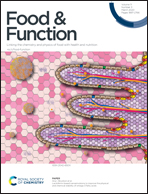In vitro bioaccessibility of minerals from microalgae-enriched cookies
Abstract
Microalgae have several biologically active constituents such as pigments, fatty acids, vitamins, and minerals, among others. Nowadays, there are numerous commercial applications for microalgae in food and animal feed. Minerals have many functions in the human body, from structural to metabolic function; as mineral absorption by the human body is important, its study is also key because of anti-nutritional factors responsible for lowering the bioaccessibility of these minerals. The aim of this work was to evaluate the mineral bioaccessibility in cookies, enriched with Arthrospira platensis (Spirulina) and Chlorella vulgaris, using in vitro static systems that simulate digestive processes. Using microalgae as an ingredient to enrich cookies with minerals was a good alternative because cookies presented a higher content of minerals compared to control samples. When the microalgae concentration in formulation increased (within studied range), higher P, Se, Na, and Mg amounts were observed in cookies. Cookies enriched with 1.5 or 2% Chlorella or Spirulina are foods classed as “high in selenium”. Incorporating A. platensis and C. vulgaris in cookie formulations, therefore, allowed greater accessibility of P, K, Ca, Mg, Fe, Zn, and Se for absorption in the body, compared with control cookies.



 Please wait while we load your content...
Please wait while we load your content...